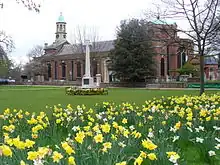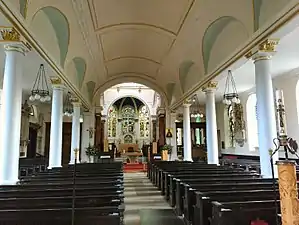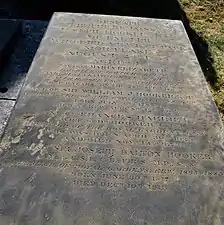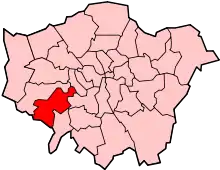| St Anne's Church, Kew | |
|---|---|
| The Parish Church of St Anne, Kew | |
 St Anne's and the Kew war memorial in the spring | |
| 51°29′02″N 0°17′16″W / 51.4838°N 0.2879°W | |
| Location | Kew Green, Kew, Richmond TW9 3AA |
| Country | England, United Kingdom |
| Denomination | Church of England |
| Website | saintanne-kew |
| History | |
| Founded | 1714 |
| Founder(s) | Queen Anne |
| Dedication | 12 May 1714[1] |
| Architecture | |
| Years built | 1714 |
| Administration | |
| Diocese | Southwark |
| Episcopal area | Kingston |
| Archdeaconry | Wandsworth |
| Deanery | Richmond & Barnes |
| Parish | St Anne, Kew |
| Clergy | |
| Bishop(s) | Christopher Chessun |
| Vicar(s) | The Revd Canon Giles Fraser |
| Dean | Tim Marwood |
| Assistant | Nick Darby |
| Archdeacon | John Kiddle |
| Laity | |
| Organist/Director of music | Julian Kelly |
| Churchwarden(s) | Cate Lyon, John Mortley |
Listed Building – Grade II* | |
| Official name | Parish Church of St Anne |
| Designated | 10 January 1950 |
| Reference no. | 1194022 |
St Anne's Church, Kew, is a parish church in Kew in the London Borough of Richmond upon Thames. The building, which dates from 1714, and is Grade II* listed,[2] forms the central focus of Kew Green. The raised churchyard, which is on three sides of the church,[3] has two Grade II* listed monuments – the tombs of the artists Johan Zoffany (d. 1816)[4] and Thomas Gainsborough (d. 1788).[5] The French Impressionist painter Camille Pissarro (1830–1903), who stayed in 1892 at 10 Kew Green,[6] portrayed St Anne's in his painting Church at Kew (1892).[7]
Services
On Sundays the church holds three morning services – a Said Eucharist in traditional language, Morning Prayer and a Sung Eucharist. An Evening Prayer is held.[8]
Music
The church is used as a venue for concerts,[9] including those of the local orchestra, Kew Sinfonia.[10]
History
Originally built in 1714 on land given by Queen Anne,[3] as a church within the parish of Kingston, St Anne's Church has been extended several times since, as the settlement of Kew grew with royal patronage. In 1770, King George III undertook to pay for the first extension, designed by Joshua Kirby[3] who, four years later, was buried in the churchyard. The church became a parish church in its own right in 1788. In 1805, a new south aisle, designed by Robert Browne,[11] was added, along with a gallery for the royal family's own use. Under King William IV it was further extended in 1837 by Sir Jeffry Wyattville.[11] A mausoleum designed by the architect Benjamin Ferrey[11] was added in 1851 and an eastern extension, including a dome, in 1882/4. This was to the designs of Henry Stock.[12] Further extensions occurred in 1902, 1979 and 1988.[1] The interior of the roof was repainted in 2013. To mark the church's tercentenary in 2014, a new baptismal font was installed.[13]
The present parish hall, which is at right angles to the church and incorporates the previous choir vestry, was built in 1978. Its design echoes the materials and forms of the church building.[3]
A collection of funerary hatchments honouring deceased royal or noble parishioners is on display in front of the church's gallery, flanking a rare representation of Queen Anne's coat of arms. A hatchment commemorating George III's son, Ernest Augustus, King of Hanover, was hung in the church in 1821. It is now in the collection of the Museum of Richmond.[14] Inside the church are fine memorials, including ones to the Hooker family.[15]
Just outside the church walls, on the south side, is the Kew war memorial, in the form of a large stone cross, commemorating the local people who fell in the First and Second World Wars.[16] Their names are listed not on the memorial, but inside the church in a monument by William Sharpington.[17][16]
Events
Baptisms
- Francis Perceval Eliot, soldier, auditor and man of letters, 9 October 1755
Marriages
- Francis, Duke of Teck married Princess Mary Adelaide of Cambridge, 12 June 1866.[18] Their daughter, "May", married George V and was known as Queen Mary.
Burials
- William Aiton (d. 1793), first keeper of the Royal Botanic Gardens, Kew[19][20][21]
- William Townsend Aiton (d. 1849) son of above, English botanist, royal gardener.[22][23]
- Franz Bauer (d. 1840), the Austrian microscopist and botanical artist,[19] whose epitaph also pays tribute to his brother the botanical illustrator Ferdinand Bauer (d. 1826): "In the delineation of plants he [Franz] united the accuracy of a profound naturalist with the skill of the accomplished artist, to a degree which has been only equalled by his brother Ferdinand"
- Professor John Patrick Micklethwait Brenan (d. 1985), British botanist, and director of the Royal Botanic Gardens, Kew[24]
- George Engleheart (d. 1829), painter of portrait miniatures to the Court of King George III
- Thomas Gainsborough (d. 1788), English portrait and landscape painter
- Rev. Thomas Haverfield (d. 1866), chaplain to Prince Augustus Frederick, Duke of Sussex
- Sir William Hooker (d. 1865), director of the Royal Gardens at Kew, and his son, English botanist and explorer Sir Joseph Hooker (d. 1911)[19]
- Joshua Kirby (d. 1774), 18th-century painter known for his work on linear perspective
- Richard Levett (d. 1711), Lord Mayor of London and former owner of Kew Palace; and members of his family, including his grandson, Rev Abraham Blackborne (d. 1797) and his wife Frances,[25] and Lincoln's Inn barrister Levett Blackborne (d. 1781), who sold Kew Palace to the royal family[26][27]
- Jeremiah Meyer (d. 1789), English miniature painter[19]
- John Smith (d. 1888), botanist and the first curator at the Royal Botanic Gardens, Kew
- Johan Zoffany (d. 1810), German neoclassical painter active in England[4]
Formerly buried at St Anne's
- Prince Adolphus, Duke of Cambridge and his wife Princess Augusta of Hesse-Kassel were buried at the east end of the church in 1850 and 1889 respectively, but in 1930 their remains were exhumed and buried at St George's Chapel, Windsor Castle.[19][28]
Gallery
Church exterior
 St Anne's Church in the snow
St Anne's Church in the snow East end of the church. The small domed building is the cenotaph of Prince Adolphus, Duke of Cambridge and his wife Princess Augusta of Hesse-Kassel
East end of the church. The small domed building is the cenotaph of Prince Adolphus, Duke of Cambridge and his wife Princess Augusta of Hesse-Kassel
Church interior
 Interior of St Anne's
Interior of St Anne's
Tombs and memorials
 Memorial to George Engleheart, who is buried at the church
Memorial to George Engleheart, who is buried at the church Tomb of Thomas Gainsborough
Tomb of Thomas Gainsborough Hooker family grave
Hooker family grave Tomb of Johan Zoffany
Tomb of Johan Zoffany.jpg.webp) War memorial on Kew Green
War memorial on Kew Green
See also
References
- 1 2 Cummings, Rosie (August 2007). "St Anne's Church. Kew Green, Kew. London Borough of Richmond: an archaeological watching brief" (PDF). Compass Archaeology. Retrieved 5 June 2015.
- ↑ Historic England (10 January 1950). "Parish Church of St Anne (1194022)". National Heritage List for England. Retrieved 24 September 2016.
- 1 2 3 4 "The History of St Anne's Church, Kew". St Anne's Church, Kew. 2010. Retrieved 20 April 2010.
- 1 2 Historic England (25 June 1983). "Churchyard of Church of St Anne, to East of Church (1357735)". National Heritage List for England. Retrieved 24 September 2016.
- ↑ Historic England (10 January 1950). "Churchyard of Church of St Anne, to South of Church (1065407)". National Heritage List for England. Retrieved 24 August 2020.
- ↑ Richardson, David. "Pissarro's home on Kew Green". London Borough of Richmond upon Thames. Archived from the original on 17 October 2013. Retrieved 30 January 2016.
- ↑ "Church at Kew". Camille Pissarro. WikiArt. Retrieved 29 March 2015.
- ↑ "Sunday Services". Our Church. St Anne's Church, Kew. Retrieved 25 July 2017.
- ↑ "Concerts and Events at St. Anne's". St Anne's Church, Kew. Retrieved 5 July 2020.
- ↑ "Kew Sinfonia". Retrieved 14 July 2017.
- 1 2 3 Cherry, Bridget and Pevsner, Nikolaus (1983). The Buildings of England – London 2: South. London: Penguin Books. p. 503. ISBN 0-14-0710-47-7.
{{cite book}}: CS1 maint: multiple names: authors list (link) - ↑ Cherry, Bridget and Pevsner, Nikolaus (2002). London 2: South. The Buildings of England. New Haven, US and London: Yale University Press. p. 503. ISBN 978-0-300-09651-4.
{{cite book}}: CS1 maint: multiple names: authors list (link) - ↑ "The Font". St Anne's Church, Kew. March 2014. Retrieved 17 July 2017.
- ↑ "Hatchment from St Anne's Church, Kew, 1821". Highlights of the Collection. Museum of Richmond. Retrieved 20 November 2013.
- ↑ "Kew Church Monuments". The Second Website of Bob Speel.
- 1 2 Mollett, Marian (2015). "Remembering the Men of Kew" (PDF). Richmond History: Journal of the Richmond Local History Society. 36: 10–23. ISSN 0263-0958. Retrieved 4 November 2023.
- ↑ Craven, Stephen (29 November 2012). "War Memorial on Kew Green". Geograph Britain and Ireland. Retrieved 5 June 2015.
- ↑ Weir, Alison (1996). Britain's Royal Families: The Complete Genealogy (revised edition). Pimlico, London: Random House. ISBN 978-071267448-5.
- 1 2 3 4 5 "St Anne's Church, Kew Green" (PDF). Local History Notes from Richmond Libraries’ Local Studies Collection. London Borough of Richmond upon Thames. Retrieved 1 July 2015.
- ↑ Pagnamenta, Frank. "Royal Gardeners at Kew – The Aitons". Richmond Local History Society.
- ↑ "Aiton, William (1731–1793), horticulturist". Oxford Dictionary of National Biography. doi:10.1093/ref:odnb/260. Retrieved 12 May 2023.
- ↑ "Aiton, William Townsend (1766–1849), horticulturist". Oxford Dictionary of National Biography. doi:10.1093/ref:odnb/262. Retrieved 12 May 2023.
- ↑ "Aiton, William (1731–1793), horticulturist". Oxford Dictionary of National Biography. doi:10.1093/ref:odnb/260. Retrieved 12 May 2023.
- ↑ Verdcourt, Bernard (1987). "John Patrick Micklethwait Brenan". Kew Bulletin. 42 (2): 286–29. JSTOR 4109685.
- ↑ Howard, Joseph Jackson. Miscellanea Genealogica et Heraldica, Vol. II, Hamilton, Adams, and Co., London, 1876, p. 13.
- ↑ Lysons, Daniel (1796). "Appendix: Corrections to volume 1, Burials in the Kew Church". The Environs of London: Counties of Herts, Essex & Kent. London: Institute of Historical Research. p. 459. Retrieved 14 December 2012.
- ↑ "Biography of Sir Richard Levett (−1711), and his family". Manuscripts and Special Collections. University of Nottingham. Retrieved 8 December 2013.
- ↑ Knowles, Rachel (8 April 2013). "Prince Adolphus, Duke of Cambridge". Regency History. Retrieved 5 July 2020.
External links
- Official website
- St Anne's Church, Kew at Find a Grave
- "St Anne's Church, Kew Green" (PDF). Local History Notes from Richmond Libraries’ Local Studies Collection. London Borough of Richmond upon Thames.
- The Friends of St Anne's Church, Kew
- Speel, Bob: Kew Church Monuments (Monuments at St Anne's)
Further reading
- Blomfield, David (2014). St Anne's Kew, 1714–2014. R J L Smith and Associates. ISBN 978-0-9573492-8-5.
- Blomfield, David (2014). "Queen Anne's Little Church". Richmond History: Journal of the Richmond Local History Society. 35: 18–24. ISSN 0263-0958.
- Cassidy, G E (1981). "The eccentric Vicar of Kew, the Revd Caleb Colton, 1780–1832". Richmond History: Journal of the Richmond Local History Society. 2: 13–16. ISSN 0263-0958.
- Cassidy, G E (1984). "Extracts from the Kew Church Archives". Richmond History: Journal of the Richmond Local History Society. 5: 14–21. ISSN 0263-0958.
- Cassidy, G E (1985). "The first Organ at St Anne's Church, Kew Green". Richmond History: Journal of the Richmond Local History Society. 6: 39–41. ISSN 0263-0958.
- Cassidy, G E (1987). "The Pew cushions in St Anne's Church, Kew". Richmond History: Journal of the Richmond Local History Society. 8: 33–41. ISSN 0263-0958.
- Mollett, Marian (2015). "Remembering the Men of Kew" (PDF). Richmond History: Journal of the Richmond Local History Society. 36: 10–23. ISSN 0263-0958. Retrieved 4 November 2023.
- Moses, John (2020). "St Anne's Church, Kew and its architectural attributions". Richmond History: Journal of the Richmond Local History Society. 41: 53–58. ISSN 0263-0958.

